Debate on Euthanasia and Withdrawing Treatment in Healthcare
VerifiedAdded on 2023/06/15
|7
|1259
|145
Essay
AI Summary
This essay presents a debate write-up focusing on the ethical considerations of euthanasia versus withdrawing medical treatment, particularly within the context of advanced care directives. The author, acting as the third speaker for the affirmative team, argues that when advanced care is considered in care planning and delivery, euthanasia and withdrawing medical treatment are more similar than different. The essay supports this argument by discussing advanced care directives as a key element of patient-centered care, allowing patients to specify their wishes regarding healthcare decisions when they are unable to do so themselves. The author rebuts the opposing team's argument by emphasizing that withdrawal of medical treatment is ethical due to patient consent, and under advanced care directives, physician-assisted suicide or euthanasia is permissible with conscious patient consent. The essay concludes by reaffirming the team line that there is no fundamental difference between euthanasia and withdrawing medical treatment when advanced care directives are in place, as both respect the patient's dignified choice, and the outcome is similar.

Running head: DEBATE WRITE UP
Debate write up
Name of the student:
Name of the university:
Author note:
‘
Debate write up
Name of the student:
Name of the university:
Author note:
‘
Paraphrase This Document
Need a fresh take? Get an instant paraphrase of this document with our AI Paraphraser
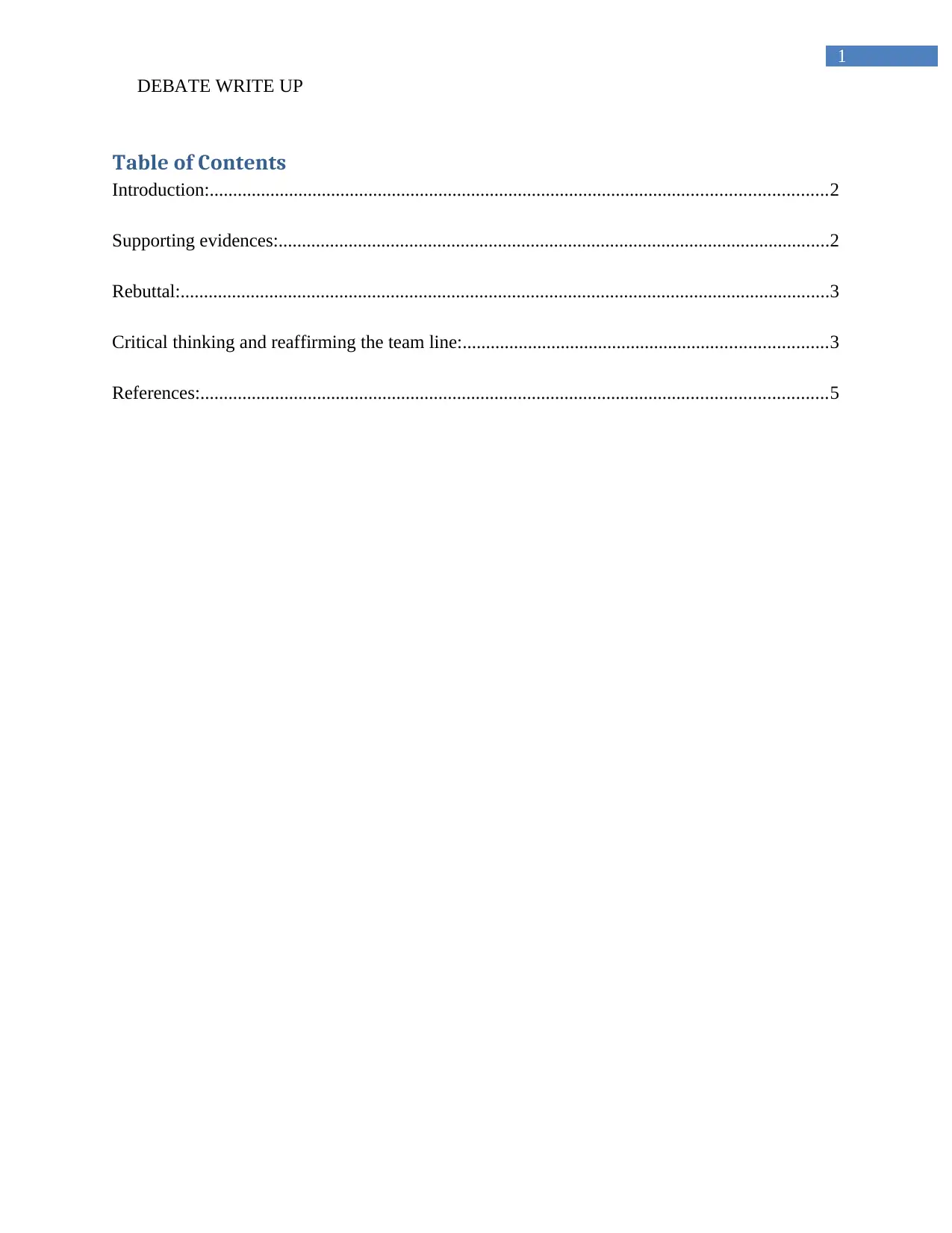
1
DEBATE WRITE UP
Table of Contents
Introduction:....................................................................................................................................2
Supporting evidences:......................................................................................................................2
Rebuttal:...........................................................................................................................................3
Critical thinking and reaffirming the team line:..............................................................................3
References:......................................................................................................................................5
DEBATE WRITE UP
Table of Contents
Introduction:....................................................................................................................................2
Supporting evidences:......................................................................................................................2
Rebuttal:...........................................................................................................................................3
Critical thinking and reaffirming the team line:..............................................................................3
References:......................................................................................................................................5
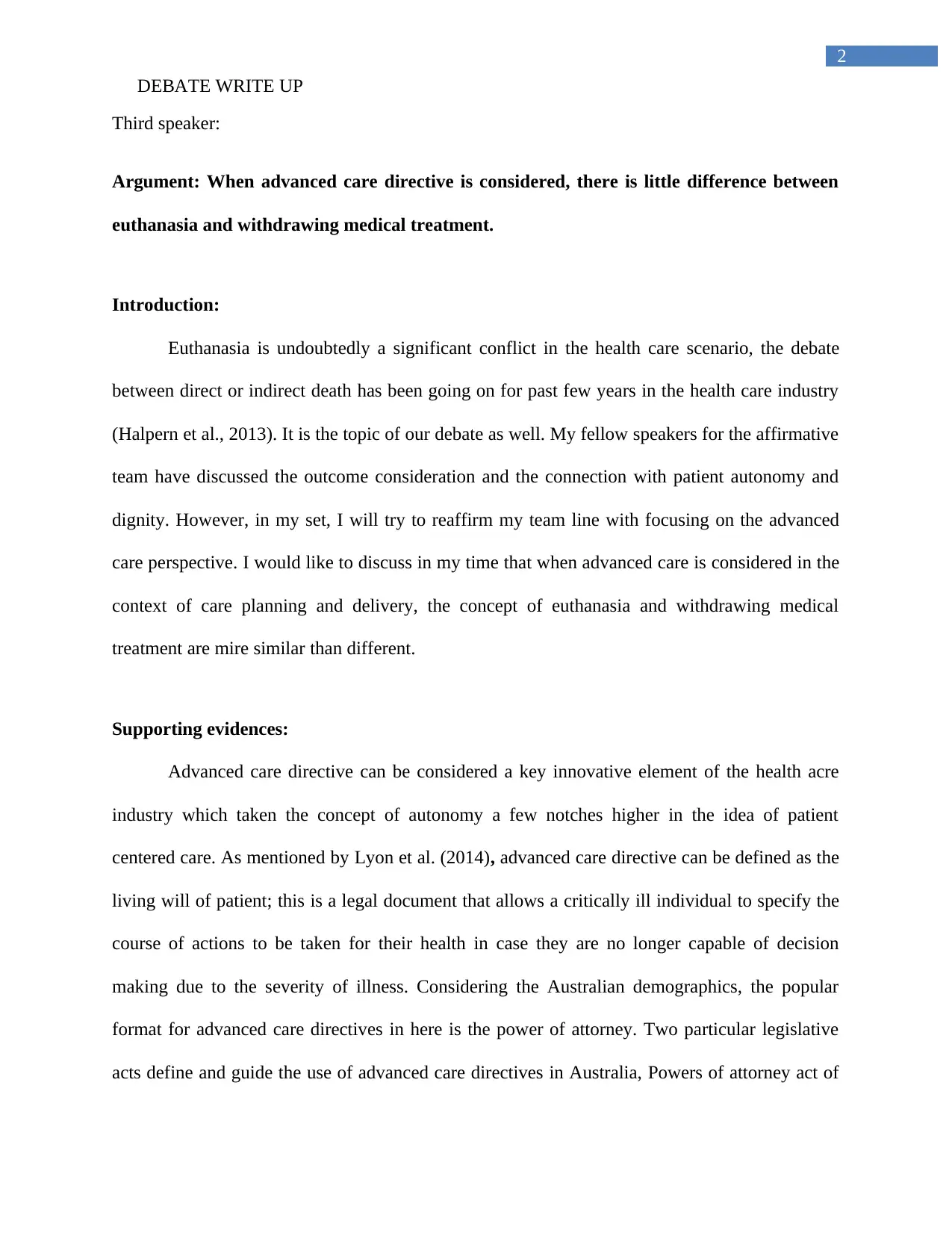
2
DEBATE WRITE UP
Third speaker:
Argument: When advanced care directive is considered, there is little difference between
euthanasia and withdrawing medical treatment.
Introduction:
Euthanasia is undoubtedly a significant conflict in the health care scenario, the debate
between direct or indirect death has been going on for past few years in the health care industry
(Halpern et al., 2013). It is the topic of our debate as well. My fellow speakers for the affirmative
team have discussed the outcome consideration and the connection with patient autonomy and
dignity. However, in my set, I will try to reaffirm my team line with focusing on the advanced
care perspective. I would like to discuss in my time that when advanced care is considered in the
context of care planning and delivery, the concept of euthanasia and withdrawing medical
treatment are mire similar than different.
Supporting evidences:
Advanced care directive can be considered a key innovative element of the health acre
industry which taken the concept of autonomy a few notches higher in the idea of patient
centered care. As mentioned by Lyon et al. (2014), advanced care directive can be defined as the
living will of patient; this is a legal document that allows a critically ill individual to specify the
course of actions to be taken for their health in case they are no longer capable of decision
making due to the severity of illness. Considering the Australian demographics, the popular
format for advanced care directives in here is the power of attorney. Two particular legislative
acts define and guide the use of advanced care directives in Australia, Powers of attorney act of
DEBATE WRITE UP
Third speaker:
Argument: When advanced care directive is considered, there is little difference between
euthanasia and withdrawing medical treatment.
Introduction:
Euthanasia is undoubtedly a significant conflict in the health care scenario, the debate
between direct or indirect death has been going on for past few years in the health care industry
(Halpern et al., 2013). It is the topic of our debate as well. My fellow speakers for the affirmative
team have discussed the outcome consideration and the connection with patient autonomy and
dignity. However, in my set, I will try to reaffirm my team line with focusing on the advanced
care perspective. I would like to discuss in my time that when advanced care is considered in the
context of care planning and delivery, the concept of euthanasia and withdrawing medical
treatment are mire similar than different.
Supporting evidences:
Advanced care directive can be considered a key innovative element of the health acre
industry which taken the concept of autonomy a few notches higher in the idea of patient
centered care. As mentioned by Lyon et al. (2014), advanced care directive can be defined as the
living will of patient; this is a legal document that allows a critically ill individual to specify the
course of actions to be taken for their health in case they are no longer capable of decision
making due to the severity of illness. Considering the Australian demographics, the popular
format for advanced care directives in here is the power of attorney. Two particular legislative
acts define and guide the use of advanced care directives in Australia, Powers of attorney act of
⊘ This is a preview!⊘
Do you want full access?
Subscribe today to unlock all pages.

Trusted by 1+ million students worldwide
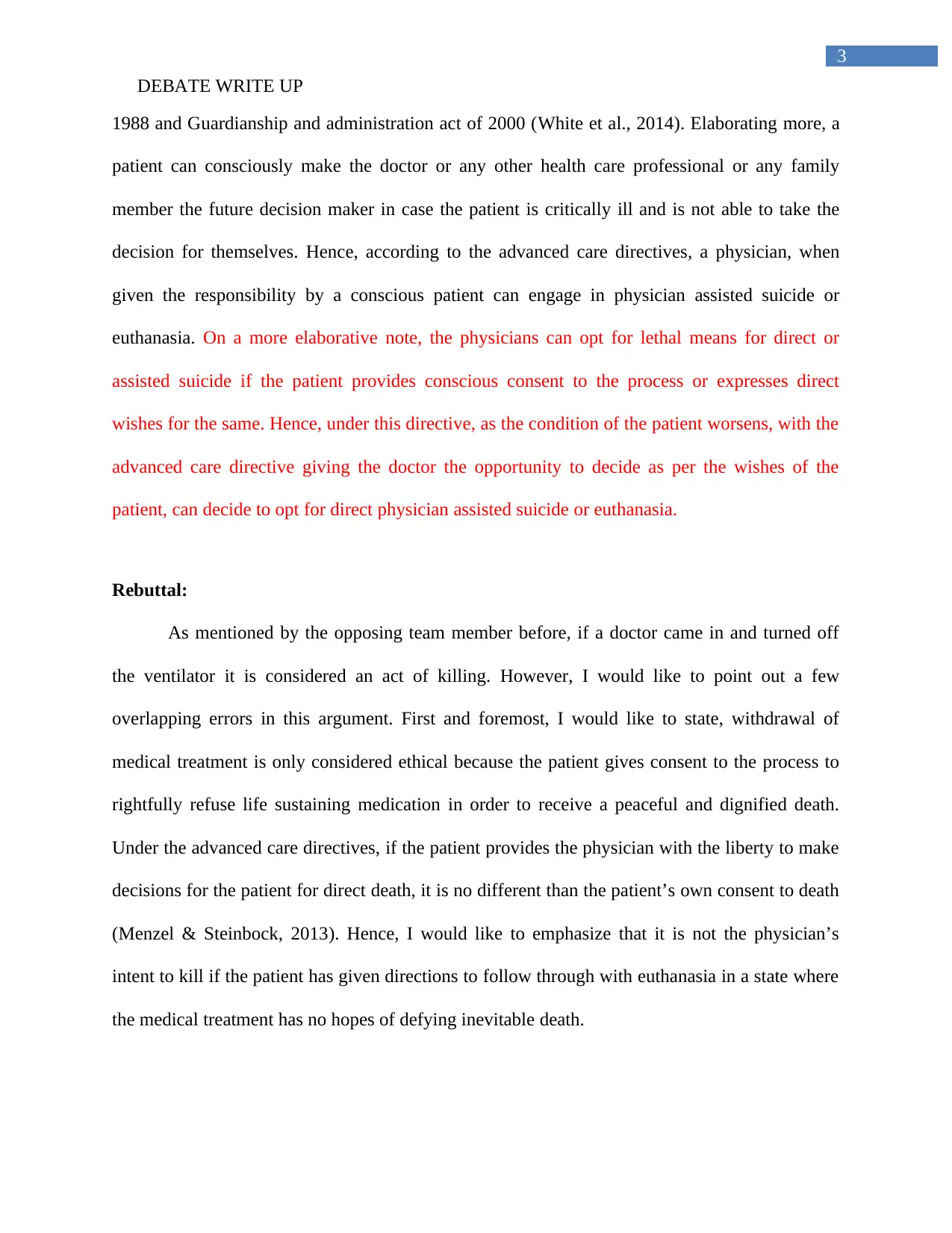
3
DEBATE WRITE UP
1988 and Guardianship and administration act of 2000 (White et al., 2014). Elaborating more, a
patient can consciously make the doctor or any other health care professional or any family
member the future decision maker in case the patient is critically ill and is not able to take the
decision for themselves. Hence, according to the advanced care directives, a physician, when
given the responsibility by a conscious patient can engage in physician assisted suicide or
euthanasia. On a more elaborative note, the physicians can opt for lethal means for direct or
assisted suicide if the patient provides conscious consent to the process or expresses direct
wishes for the same. Hence, under this directive, as the condition of the patient worsens, with the
advanced care directive giving the doctor the opportunity to decide as per the wishes of the
patient, can decide to opt for direct physician assisted suicide or euthanasia.
Rebuttal:
As mentioned by the opposing team member before, if a doctor came in and turned off
the ventilator it is considered an act of killing. However, I would like to point out a few
overlapping errors in this argument. First and foremost, I would like to state, withdrawal of
medical treatment is only considered ethical because the patient gives consent to the process to
rightfully refuse life sustaining medication in order to receive a peaceful and dignified death.
Under the advanced care directives, if the patient provides the physician with the liberty to make
decisions for the patient for direct death, it is no different than the patient’s own consent to death
(Menzel & Steinbock, 2013). Hence, I would like to emphasize that it is not the physician’s
intent to kill if the patient has given directions to follow through with euthanasia in a state where
the medical treatment has no hopes of defying inevitable death.
DEBATE WRITE UP
1988 and Guardianship and administration act of 2000 (White et al., 2014). Elaborating more, a
patient can consciously make the doctor or any other health care professional or any family
member the future decision maker in case the patient is critically ill and is not able to take the
decision for themselves. Hence, according to the advanced care directives, a physician, when
given the responsibility by a conscious patient can engage in physician assisted suicide or
euthanasia. On a more elaborative note, the physicians can opt for lethal means for direct or
assisted suicide if the patient provides conscious consent to the process or expresses direct
wishes for the same. Hence, under this directive, as the condition of the patient worsens, with the
advanced care directive giving the doctor the opportunity to decide as per the wishes of the
patient, can decide to opt for direct physician assisted suicide or euthanasia.
Rebuttal:
As mentioned by the opposing team member before, if a doctor came in and turned off
the ventilator it is considered an act of killing. However, I would like to point out a few
overlapping errors in this argument. First and foremost, I would like to state, withdrawal of
medical treatment is only considered ethical because the patient gives consent to the process to
rightfully refuse life sustaining medication in order to receive a peaceful and dignified death.
Under the advanced care directives, if the patient provides the physician with the liberty to make
decisions for the patient for direct death, it is no different than the patient’s own consent to death
(Menzel & Steinbock, 2013). Hence, I would like to emphasize that it is not the physician’s
intent to kill if the patient has given directions to follow through with euthanasia in a state where
the medical treatment has no hopes of defying inevitable death.
Paraphrase This Document
Need a fresh take? Get an instant paraphrase of this document with our AI Paraphraser
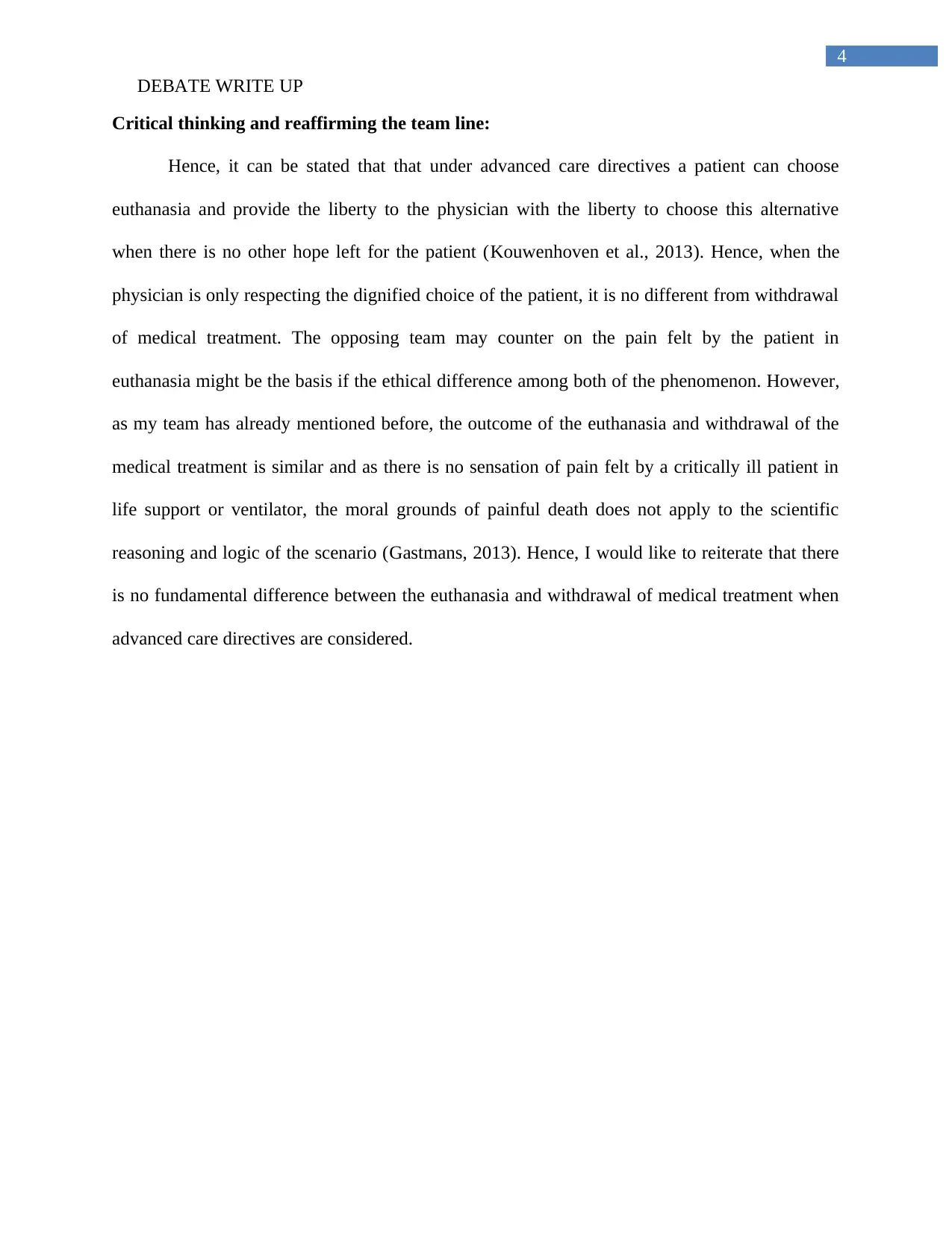
4
DEBATE WRITE UP
Critical thinking and reaffirming the team line:
Hence, it can be stated that that under advanced care directives a patient can choose
euthanasia and provide the liberty to the physician with the liberty to choose this alternative
when there is no other hope left for the patient (Kouwenhoven et al., 2013). Hence, when the
physician is only respecting the dignified choice of the patient, it is no different from withdrawal
of medical treatment. The opposing team may counter on the pain felt by the patient in
euthanasia might be the basis if the ethical difference among both of the phenomenon. However,
as my team has already mentioned before, the outcome of the euthanasia and withdrawal of the
medical treatment is similar and as there is no sensation of pain felt by a critically ill patient in
life support or ventilator, the moral grounds of painful death does not apply to the scientific
reasoning and logic of the scenario (Gastmans, 2013). Hence, I would like to reiterate that there
is no fundamental difference between the euthanasia and withdrawal of medical treatment when
advanced care directives are considered.
DEBATE WRITE UP
Critical thinking and reaffirming the team line:
Hence, it can be stated that that under advanced care directives a patient can choose
euthanasia and provide the liberty to the physician with the liberty to choose this alternative
when there is no other hope left for the patient (Kouwenhoven et al., 2013). Hence, when the
physician is only respecting the dignified choice of the patient, it is no different from withdrawal
of medical treatment. The opposing team may counter on the pain felt by the patient in
euthanasia might be the basis if the ethical difference among both of the phenomenon. However,
as my team has already mentioned before, the outcome of the euthanasia and withdrawal of the
medical treatment is similar and as there is no sensation of pain felt by a critically ill patient in
life support or ventilator, the moral grounds of painful death does not apply to the scientific
reasoning and logic of the scenario (Gastmans, 2013). Hence, I would like to reiterate that there
is no fundamental difference between the euthanasia and withdrawal of medical treatment when
advanced care directives are considered.
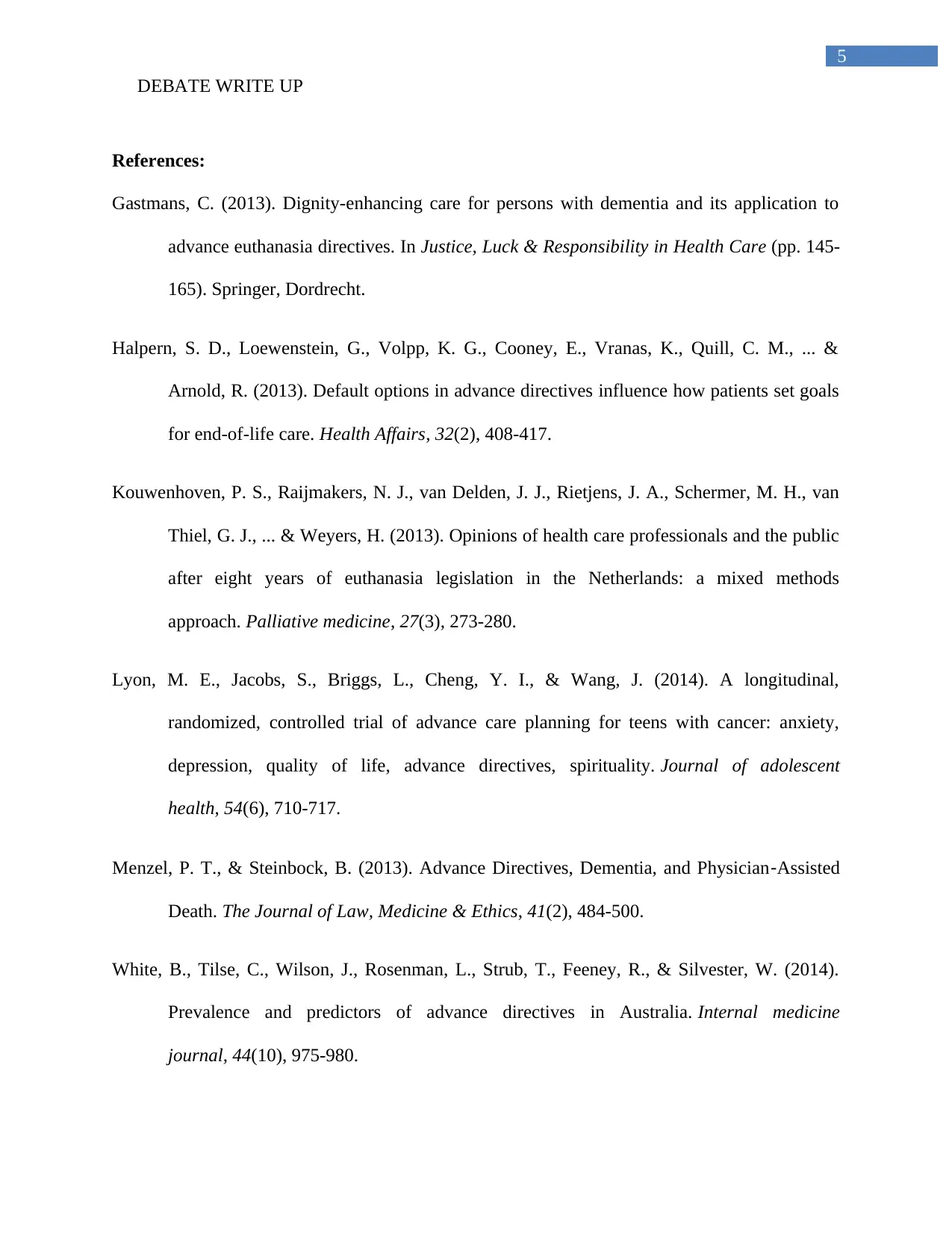
5
DEBATE WRITE UP
References:
Gastmans, C. (2013). Dignity-enhancing care for persons with dementia and its application to
advance euthanasia directives. In Justice, Luck & Responsibility in Health Care (pp. 145-
165). Springer, Dordrecht.
Halpern, S. D., Loewenstein, G., Volpp, K. G., Cooney, E., Vranas, K., Quill, C. M., ... &
Arnold, R. (2013). Default options in advance directives influence how patients set goals
for end-of-life care. Health Affairs, 32(2), 408-417.
Kouwenhoven, P. S., Raijmakers, N. J., van Delden, J. J., Rietjens, J. A., Schermer, M. H., van
Thiel, G. J., ... & Weyers, H. (2013). Opinions of health care professionals and the public
after eight years of euthanasia legislation in the Netherlands: a mixed methods
approach. Palliative medicine, 27(3), 273-280.
Lyon, M. E., Jacobs, S., Briggs, L., Cheng, Y. I., & Wang, J. (2014). A longitudinal,
randomized, controlled trial of advance care planning for teens with cancer: anxiety,
depression, quality of life, advance directives, spirituality. Journal of adolescent
health, 54(6), 710-717.
Menzel, P. T., & Steinbock, B. (2013). Advance Directives, Dementia, and Physician‐Assisted
Death. The Journal of Law, Medicine & Ethics, 41(2), 484-500.
White, B., Tilse, C., Wilson, J., Rosenman, L., Strub, T., Feeney, R., & Silvester, W. (2014).
Prevalence and predictors of advance directives in Australia. Internal medicine
journal, 44(10), 975-980.
DEBATE WRITE UP
References:
Gastmans, C. (2013). Dignity-enhancing care for persons with dementia and its application to
advance euthanasia directives. In Justice, Luck & Responsibility in Health Care (pp. 145-
165). Springer, Dordrecht.
Halpern, S. D., Loewenstein, G., Volpp, K. G., Cooney, E., Vranas, K., Quill, C. M., ... &
Arnold, R. (2013). Default options in advance directives influence how patients set goals
for end-of-life care. Health Affairs, 32(2), 408-417.
Kouwenhoven, P. S., Raijmakers, N. J., van Delden, J. J., Rietjens, J. A., Schermer, M. H., van
Thiel, G. J., ... & Weyers, H. (2013). Opinions of health care professionals and the public
after eight years of euthanasia legislation in the Netherlands: a mixed methods
approach. Palliative medicine, 27(3), 273-280.
Lyon, M. E., Jacobs, S., Briggs, L., Cheng, Y. I., & Wang, J. (2014). A longitudinal,
randomized, controlled trial of advance care planning for teens with cancer: anxiety,
depression, quality of life, advance directives, spirituality. Journal of adolescent
health, 54(6), 710-717.
Menzel, P. T., & Steinbock, B. (2013). Advance Directives, Dementia, and Physician‐Assisted
Death. The Journal of Law, Medicine & Ethics, 41(2), 484-500.
White, B., Tilse, C., Wilson, J., Rosenman, L., Strub, T., Feeney, R., & Silvester, W. (2014).
Prevalence and predictors of advance directives in Australia. Internal medicine
journal, 44(10), 975-980.
⊘ This is a preview!⊘
Do you want full access?
Subscribe today to unlock all pages.

Trusted by 1+ million students worldwide

6
DEBATE WRITE UP
DEBATE WRITE UP
1 out of 7
Related Documents
Your All-in-One AI-Powered Toolkit for Academic Success.
+13062052269
info@desklib.com
Available 24*7 on WhatsApp / Email
![[object Object]](/_next/static/media/star-bottom.7253800d.svg)
Unlock your academic potential
Copyright © 2020–2025 A2Z Services. All Rights Reserved. Developed and managed by ZUCOL.


